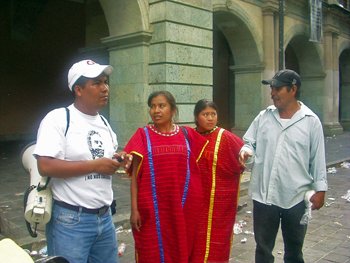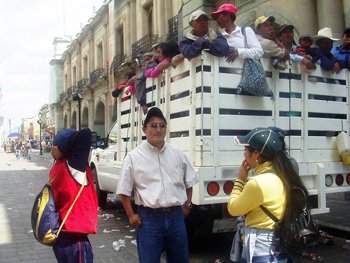


The Organizing and Mobilizing of the Oaxaca Population
Dissatisfaction with Local Governments and New Mining Projects Are Uniting a Myriad of People
By Nancy Davies
Commentary from Oaxaca
March 19, 2009
According to many people writing about social movements, people from below self-organize and self-identify. The opposite view would be that there is a vanguard or group who organize them. Two interesting events took place this week, which raise that question.
1. The first event is the symbolic closing on March 17 of the gold and silver mine San José, owned by Cuzcatlán , the operating subsidiary of the multinational Fortuna Silver Mines of Canada. This mine occupies indigenous, communal, and ejido land; historically other mines in the area were worked and shut down, it’s a rich area. In 2007 San José was re-initiated because of the higher values of gold and silver. Mines like it (for example Santa Inés belonging to Mioxa) are known to have poisoned the sub-soil water, the people and the children, causing cancer with cyanide used to wash the minerals. Cattle died and people suffered skin sores, eye infections and respiratory problems. The miners themselves (all but three) died of cyanide poisoning. Twenty years later the contamination is still evident.
In the Valley of Ocotlan, about 42 kilometers south of the city of Oaxaca, since 2006 thousands of hectares have been given in concessions to the various mining companies such as Cuzcatlán, Cuzcatlán Aplication, Aurea, Continuum, Intrepid Mines, Pan-American and others to extract gold and silver. About fourteen communities are affected.
The mining company Cuzcatlan has used a campaign of pressure, lies and threats to induce the landowners to authorize the extraction. But the people became aware of its destructive nature, including the fact that a gold mine uses 250,000 liters of water per hour, which a family would use over twenty years.
Along with the act of declaring the mine closed, the inhabitants of San José el Progreso and Magdalena Ocotlán withdrew their recognition of the town councilor Oscar Venancio Martinez Rivera, and named instead a committee of good government, simultaneously placing a guard in front of the municipal palace of San José del Progreso. The authorities had made their deals without any consultation with the people, a violation of local indigenous government practices. A twenty-year lease was granted by the government to Cuzcatlán, to operate the San José mine.
When about 200 residents gathered, joined by members of the Committee of Defense of the Rights of the People, the Coordinator in Defense of Natural Resources, and Our Mother Earth of the Valley of Ocotlán, along with the presence of Notary Public number 98 to make it official, in the presence of the community council seals were placed to declare the mine closed. The formal declaration was signed by members of the Council of Municipal Government of San José Progeso Ocotlán, the authorities of Magdlena Ocotlán and of the agencies (hamlets) Maguey Largo and El Cuajilote.
Although environmental information has never been offered, the mining company men claimed that many safeguards are now in place. For example, as an underground mine, the mine won’t contaminate the air! Cyanide will not be used to clean the gold or silver. In any case, this is still the engineering phase initiated in 2007; the actual mining would proceed later on. In rebuttal to demands by the townspeople that dynamite be removed, the company agents stated that the dynamite now stored on the property would stay, it came there legitimately, and if any townspeople or children get blown up – well, what a pity.
 Photos Nancy Davies D.R. 2009 |
Now, why is this extra-interesting? Because in February, following the national forum for water and land, a modest public meeting took place in Ocotlán to discuss the mining threat and the people’s right to defend their land, water and health. One group represented at the meeting was Section 22 of the National Union for Education Workers, SNTE in its Spanish initials. Section 22 delegates, clearly prepared beforehand, declared union and APPO backing for the mine’s protesters.
2. On March 17 the Triqui indigenous people came to Oaxaca, and the following day protested in Oaxaca, organized by the Unified Movement of Triqui Struggle (MULT). About 8,000 indigenous Triquis from the fourteen communities belonging to MULT, plus those from the ten affiliated municipalities from Putla, and members of the Popular Assembly of the Indigenous Peoples (APPI) were authorized by the transit authority to march through the city, moving from the Monument To the Mother, over Fortín Hill, down the main avenues of Niños Héroes, Juárez and Morelos. The protesters demanded the “presentation alive” of Daniela Ortiz and Virginia Ortiz Ramírez, at the time of their disappearance fourteen and twenty years old respectively. The girls vanished on July 5, 2007. The marchers made public their determination to remain in an encampment until they receive a reply to their demands, including freeing political prisoners.
Among the banners in the march one read “Total Backing for the Teachers Movement Struggle”.
The protesters asked for a dialogue to be headed by the Triqui councilor Heriberto Pazos and to include the presence of representatives of the legislature, executive and judiciary. According to Pazos, the government wants a dialogue between the deaf and dumb: the government is deaf and the indigenous people are supposed to keep their mouths shut. Some of the marchers went to the Administrative City (state government offices relocated outside of the capital). Others, according to the newspaper Despertar, focused on besieging other government offices, all the while keeping city traffic in chaos, because instead of 8,000 there was an estimated 20- 25,000 on foot.
In the zocalo where the march dispersed it was clear that Triquis had been augmented by other indigenous people who came from all seven regions of the state, plus some identified as being with La Otra Campaña (Noticias, March 19, 2009). Triqui demands have broadened from investigation of the disappearance of their young women to demands from the state government for justice and peace, freedom for political prisoners, assistance to the rural areas, food production, roads, electricity, potable water and drainage.
 Photos Nancy Davies D.R. 2009 |
In my opinion, and I have been watching this for some time, the teachers are organizing the state to mobilize in every corner. Elections take place in July, and the APPO will not take part nor support any candidates. The punishment vote, which means no PRI candidates, is already being invoked, even pleasantly enough by prelates of the Catholic Church. But wait; is it the teachers who really are organizing? Or do we see the population of Oaxaca organizing and mobilizing itself, with back-up assurance that SNTE and the popular movement stand pledged to support them, to be called upon if needed? Oaxaca united?
Click here for more Narco News coverage of Mexico
- The Fund for Authentic Journalism
For more Narco News, click here.




